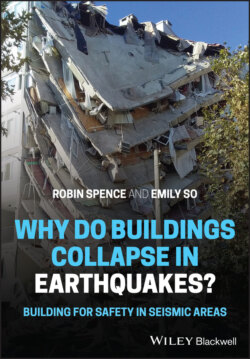Читать книгу Why do buildings collapse in earthquakes? Building for safety in seismic areas - Robin Spence - Страница 26
2.2.10 The 25.4.2015 Gorkha Nepal Earthquake: Mw7.8, 8831 Deaths
ОглавлениеThis Mw7.8 event occurred on 25 April 2015 at 11.56 a.m. local time, with an epicentre near the town of Gorkha, 80 km west of Nepal's capital city Kathmandu, and with a focal depth of 19 km. It was followed by an intense series of aftershocks over several months, with their epicentres spread over a length of 200 km east and west from the main shock. The largest of these aftershocks, on 12 May, had a magnitude of Mw7.3, and three others had magnitudes greater than Mw6.0. The earthquakes resulted from ruptures on the Himalayan arc, a highly active fault zone associated with the subduction of the Indian plate to the south under the Eurasian plate to the north, the process which is responsible for the building of the Himalayan mountain range. The cumulative casualties and damage from this sequence of events was immense. Over half a million houses were destroyed, as were many government and heritage buildings, as well as roads, bridges and water supply systems. Damage was increased by many landslides, and rescue was hampered by the inaccessibility of many affected villages. The Nepal Government's post‐disaster needs assessment report (EEFIT 2015; EERI 2016; Government of Nepal 2015) estimated that there were over 8790 deaths and 22 300 serious injuries caused by the earthquake, spread over 14 districts. The death toll subsequently rose to an estimated 8831 in Nepal. The cost of the disaster has been estimated to be around US$7bn.
Observations on building construction and damage are taken from the reports of the EEFIT and EERI reconnaissance missions (EEFIT 2015; EERI 2016). According to these reports, in both urban and rural areas of Nepal, masonry construction predominates. In the urban areas, many buildings are of three to four storeys in height, and built in close proximity to each other. Masonry is constructed using fired brick, which is laid in a lime or mud, sometimes cement, mortar. Floors and roof structures were traditionally of timber (floor planks on joists), and in better‐built houses these were connected by pegs to wall plates to prevent overturning (EEFIT 2015). More recent masonry buildings have RC floor and roof slabs. Urban areas also have a proportion of RC frame buildings, with masonry infills. Few are built according to the Nepalese code of practice or guidelines for concrete buildings, and there is no inspection (EEFIT 2015).
In rural areas masonry construction is low‐rise, using local stone or brick, with a lime or mud mortar. As in urban areas, floors have timber beams and roofs use timber beams or trusses covered with a lightweight tiles or metallic sheet.
Although better‐built structures survived the earthquake with minor damage, the earthquake exposed many weaknesses in building practice. Typical damage to masonry buildings included the separation of outer and inner layers of masonry walls because of poor connection within the walls, out‐of‐plane overturning of walls because of poor connections at corners and poor wall‐to‐floor connection (Figures 2.17 and 2.18). Many of the casualties were caused by the overturning and collapse of masonry walls. The performance of RC buildings was better than that of masonry buildings, and the majority of those observed by EEFIT, both in Kathmandu and throughout the affected area, showed little or no damage (EEFIT 2015). However, the EERI team (EERI 2016) noted many deficiencies leading to damage or collapse, which they attributed both to problems with building configuration – large overhangs, trapezoidal plans and soft storeys, as well as to poor construction standards. Pounding of adjacent structures with insufficient gaps was also a common source of damage.
Many important heritage buildings, including temples, were seriously damaged or destroyed by the earthquake. There was evidence though, that retrofitting of some traditional masonry buildings using wall ties had been effective. And the work of the National Society of Earthquake Technology, NSET, in strengthening school buildings, and in creating guidelines for improving earthquake safety of rural buildings, was considered by EEFIT (2015) to have protected many buildings from serious damage (see Chapter 7).
Figure 2.17 Typical damage to masonry construction in urban areas of Nepal.
Source: EEFIT. Reproduced with permission.
Figure 2.18 Typical damage to masonry construction in urban areas of Nepal.
Source: EERI. Reproduced with permission.
